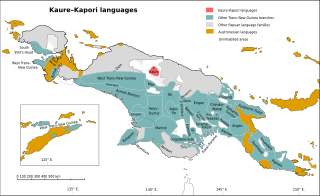Related Research Articles

Trans–New Guinea (TNG) is an extensive family of Papuan languages spoken on the island of New Guinea and neighboring islands, a region corresponding to the country Papua New Guinea as well as parts of Indonesia.
Tauya is a Rai Coast language spoken in the Ramu River valley, Madang Province, Papua New Guinea by approximately 350 people. The Linguistics Department at the University of Manitoba in Winnipeg, Canada, has Tauya language resources.
The Lakes Plain languages are a family of Papuan languages, spoken in the Lakes Plain of Indonesian New Guinea. They are notable for being heavily tonal and for their lack of nasal consonants.
Kâte is a Papuan language spoken by about 6,000 people in the Finschhafen District of Morobe Province, Papua New Guinea. It is part of the Finisterre–Huon branch of the Trans–New Guinea language family. It was adopted for teaching and mission work among speakers of Papuan languages by the Evangelical Lutheran Church of Papua New Guinea in the early 1900s and at one time had as many as 80,000 second-language speakers.

The Kaure–Kosare or Nawa River languages are a small family spoken along the Nawa River in West Papua, near the northern border with Papua New Guinea. The languages are Kaure and Kosare.

The Mek languages are a well established family of Papuan languages spoken by the Mek people and Yali people. They form a branch of the Trans–New Guinea languages (TNG) in the classifications of Stephen Wurm (1975) and of Malcolm Ross (2005).

The Chimbu–Wahgi languages are a language family of New Guinea. They are sometimes included in the Trans–New Guinea proposal; Usher links them with the Engan languages in a Central New Guinea Highlands family.
Momuna (Momina), also known as Somahai, is a Papuan language spoken in Yahukimo Regency, Highland Papua and Asmat Regency, South Papua, Indonesia.

Wiru or Witu is the language spoken by the Wiru people of Ialibu-Pangia District of the Southern Highlands Province of Papua New Guinea. The language has been described by Harland Kerr, a missionary who lived in the Wiru community for many years. Kerr's work with the community produced a Wiru Bible translation and several unpublished dictionary manuscripts, as well as Kerr's Master's thesis on the structure of Wiru verbs.
West Bird's Head languages are a small family of poorly documented Papuan languages spoken on the Bird's Head Peninsula of New Guinea.

The North Halmahera (NH) languages are a family of languages spoken in the northern and eastern parts of the island of Halmahera and some neighboring islands in Indonesia. The southwestern part of the island is occupied by the unrelated South Halmahera languages, which are a subgroup of Austronesian. They may be most closely related to the languages of the Bird's Head region of West Papua, but this is not well-established.

Pawaia, also known as Sira, Tudahwe, Yasa, is a Papuan language that forms a tentative independent branch of the Trans–New Guinea family in the classification of Malcolm Ross (2005).

Kaure is a Papuan language of West Papua. It is spoken in the villages of Lereh, Harna, Wes, Masta, and Aurina.
Foi, also known as Foe or Mubi River, is one of the two East Kutubuan languages of the Trans-New Guinea family spoken along Lake Kutubu and Mubi River, located in the Southern Highlands Province of Papua New Guinea. Dialects of Foi are Ifigi, Kafa, Kutubu, Mubi. A Swadesh list for the Foi language was documented by The Rosetta Project in 2010. The estimated number of Foi speakers as of 2015 is between 6,000 and 8,000.
Nalca is a Papuan language spoken in Yahukimo Regency, Highland Papua, Indonesia. Alternative names are Hmanggona, Hmonono, Kimnyal (Kimyal). The latter is most often used for Korupun-Sela. Indonesian Kemendikbud classified Nalca as Mek Nalca, while Kimyal is used for Korupun-Sela.

Idi is a Pahoturi language spoken in Western Province, Papua New Guinea. The so-called Pahoturi dialects form a dialect chain with Idi proper at one end and Agob proper at the other.
Kilmeri, or bo apulyo is a Papuan language of Papua New Guinea near the border with Indonesian Papua. It is not being learned by children.
Kosarek is a Papuan language used in Kosarek District, Yahukimo Regency, Highland Papua.
Nen is a Yam language spoken in the Bimadbn village in the Western Province of Papua New Guinea, with 250 speakers as of a 2002 SIL survey. It is situated between the speech communities of Nambu and Idi.
Proto-Trans–New Guinea is the reconstructed proto-language ancestral to the Trans–New Guinea languages. Reconstructions have been proposed by Malcolm Ross and Andrew Pawley.
References
- 1 2 Eipo at Ethnologue (25th ed., 2022)

- ↑ Heeschen 1998, p. 18.
- 1 2 3 Heeschen 1998, p. 117.
- 1 2 Heeschen 1998, p. 118.
- 1 2 Pawley, Andrew; Hammarström, Harald (2018). "The Trans New Guinea family". In Palmer, Bill (ed.). The Languages and Linguistics of the New Guinea Area: A Comprehensive Guide. The World of Linguistics. Vol. 4. Berlin: De Gruyter Mouton. pp. 21–196. ISBN 978-3-11-028642-7.
- Heeschen, Volker (1998). An Ethnographic Grammar of the Eipo Language (spoken in the central mountains of Irian Jaya (West New Guinea), Indonesia). Berlin: Reimer.
- Heeschen, Volker and Wulf Schiefenhövel. 1983. Wörterbuch der Eiposprache: Eipo-Deutsch-Englisch. Berlin: Dietrich Reimer.